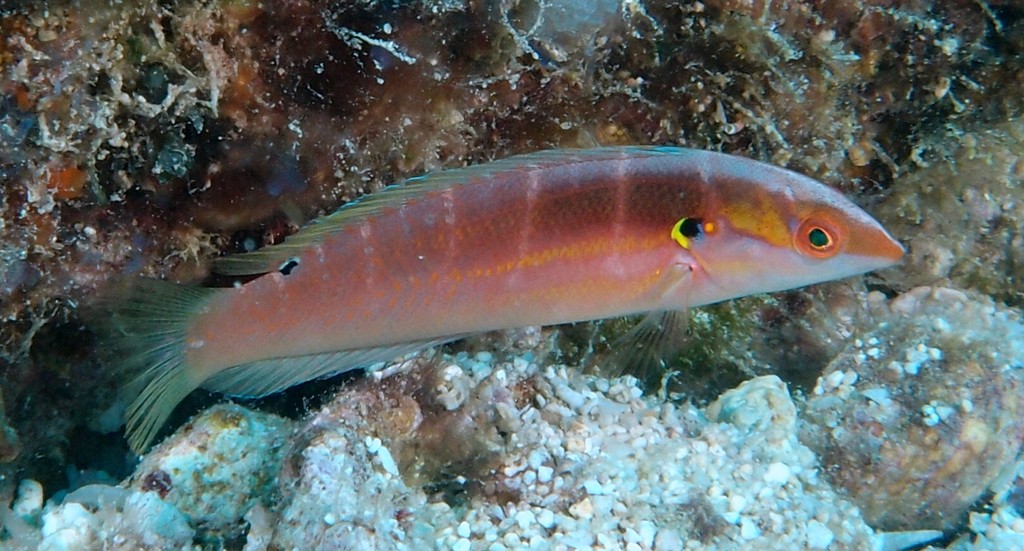CORIS DORSOMACULA - (FOWLER, 1908)
Actinopterygii (Gigaclass) > Actinopteri (Class) > Teleostei (Subclass) > Labriformes (Order) > Labroidei (Suborder) > Labridae (Family) > Coris (Genus)
Pale-barred coris, Pink-lined coris, Pink-lined rainbow wrasse, Pinklined wrasse, Spotfin coris, Spotfin wrasse, Sujibera,
Synonymes
Coris dorsomaculata (Fowler, 1908)
Coris dorsumacula (Fowler, 1908)
----------------------------
Description
Dorsal spines (total): 9; Dorsal soft rays (total): 12; Anal spines: 3; Anal soft rays: 12. Adult Pinklined Wrasse have narrow pale bars crossing the sides of the body. There are two pinkish stripes along the belly that break into blotches above the anal fin. On the caudal fin there is a boomerang-shaped red band. The cheek is crossed by two pink stripes and there is usually a spot on the operculum that often has a yellow border posteriorly. Juveniles have a simpler pattern that becomes more complex with growth. They have narrow pale bars on the side of the body and often a brownish stripe along the head and body. They usually have a yellow-bordered spot on the operculum.
First 2 dorsal-fin spines with flexible tips slightly longer than other dorsal-fin spines. Max length : 38.0 cm. Depth range 2 - 40 m.
Etymology
Coris: from Greek, coris = summit, head. Name given to this genus by Philibert Commerson (1727-1773), referring to scaly plate that encompasses skull, eyes and jaws of all wrasses.
Pale-barred coris, Pink-lined coris, Pink-lined rainbow wrasse, Pinklined wrasse, Spotfin coris, Spotfin wrasse, Sujibera,
Synonymes
Coris dorsomaculata (Fowler, 1908)
Coris dorsumacula (Fowler, 1908)
----------------------------
Description
Dorsal spines (total): 9; Dorsal soft rays (total): 12; Anal spines: 3; Anal soft rays: 12. Adult Pinklined Wrasse have narrow pale bars crossing the sides of the body. There are two pinkish stripes along the belly that break into blotches above the anal fin. On the caudal fin there is a boomerang-shaped red band. The cheek is crossed by two pink stripes and there is usually a spot on the operculum that often has a yellow border posteriorly. Juveniles have a simpler pattern that becomes more complex with growth. They have narrow pale bars on the side of the body and often a brownish stripe along the head and body. They usually have a yellow-bordered spot on the operculum.
First 2 dorsal-fin spines with flexible tips slightly longer than other dorsal-fin spines. Max length : 38.0 cm. Depth range 2 - 40 m.
Etymology
Coris: from Greek, coris = summit, head. Name given to this genus by Philibert Commerson (1727-1773), referring to scaly plate that encompasses skull, eyes and jaws of all wrasses.
Distribution
Western Pacific: Christmas Island (eastern Indian Ocean) and South China Sea, east to Fiji, north to Japan and Ogasawara Islands, south to northern Australia, New Caledonia and Kermadec Islands.
Biology
Found in coastal to outer reef habitats in deep gutters or along reef margins. Inhabits rocky and coral reefs, in areas with rubble, weed and sand. Found solitary. It likely feeds on micro-zoobenthos. This is a common and wide-ranging species. There are no major threats currently known, and it is therefore listed as Least Concern. It may occasionally be taken in the aquarium trade, but the level of utilization does not appear to be causing population declines. This species occurs in some marine protected areas throughout its range.
Western Pacific: Christmas Island (eastern Indian Ocean) and South China Sea, east to Fiji, north to Japan and Ogasawara Islands, south to northern Australia, New Caledonia and Kermadec Islands.
Biology
Found in coastal to outer reef habitats in deep gutters or along reef margins. Inhabits rocky and coral reefs, in areas with rubble, weed and sand. Found solitary. It likely feeds on micro-zoobenthos. This is a common and wide-ranging species. There are no major threats currently known, and it is therefore listed as Least Concern. It may occasionally be taken in the aquarium trade, but the level of utilization does not appear to be causing population declines. This species occurs in some marine protected areas throughout its range.
